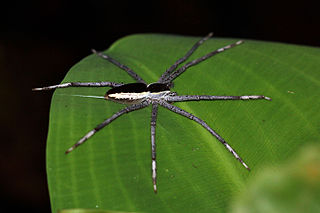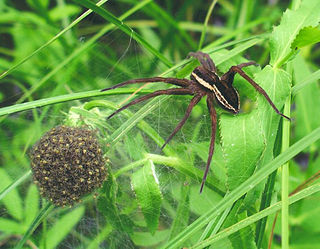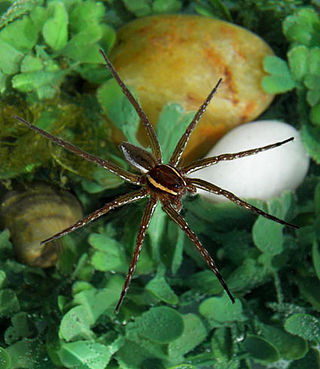
Nursery web spiders (Pisauridae) are a family of araneomorph spiders first described by Eugène Simon in 1890. Females of the family are known for building special nursery webs. When their eggs are about to hatch, a female spider builds a tent-like web, places her egg sac inside, and stands guard outside, hence the family's common name. Like wolf spiders, however, nursery web spiders are roaming hunters that do not use webs for catching prey.

Dolomedes is a genus of large spiders of the family Dolomedidae. They are also known as fishing spiders, raft spiders, dock spiders or wharf spiders. Almost all Dolomedes species are semiaquatic, with the exception of the tree-dwelling D. albineus of the southeastern United States. Many species have a striking pale stripe down each side of the body.

The raft spider, scientific name Dolomedes fimbriatus, is a large semi-aquatic spider of the family Dolomedidae found throughout north-western and central Europe. It is one of only two species of the genus Dolomedes found in Europe, the other being the slightly larger Dolomedesplantarius which is endangered in the UK.

Selenocosmia crassipes, synonym Phlogius crassipes, also known as the "Queensland whistling tarantula", "barking spider" or "bird-eating tarantula" is a species of tarantula native to the east coast of Queensland, Australia. The name "whistling tarantula" comes from its ability to produce a hissing noise when provoked, a trait it shares with other Australian theraphosids. This hissing is produced by the spider stridulating a patch of setae associated with its chelicerae. It has also been called the "eastern tarantula". The species name crassipes is Latin for "fat leg" referring to the relatively fat front legs.

Dolomedes minor is a spider in the family Dolomedidae that is endemic to New Zealand, where it is known as the nursery web spider.

The great raft spider or fen raft spider is a European species of spider in the family Dolomedidae. Like other Dolomedes spiders, it is semiaquatic, hunting its prey on the surface of water. It occurs mainly in neutral to alkaline, unpolluted water of fens and grazing marsh.

Dolomedes aquaticus is a species of fishing spider that lives and hunts along the gravel banks of unforested New Zealand rivers. It prefer open riverbanks where it typically lives under rocks, usually less than 5 metres away from the river. Its colouring allows it to camouflage against river stones. Normally nocturnal, it will sit and wait for prey after dark, and can survive for short periods under the water.

Dolomedes tenebrosus, known as the dark fishing spider, is a species of fishing spider found in the United States and Canada.

Dolomedes scriptus is a fishing spider found in the United States and Canada, known as the striped fishing spider. Female spiders can grow to be over 6 cm in legspan. The spider is a pale brown colour with lighter stripes around its legs and a stripe down each side of the body. It is similar to D. tenebrosus.

The six-spotted fishing spider is a species of spider in the family Dolomedidae. Found in wetland habitats throughout North America, these spiders are usually seen scampering along the surface of ponds and other bodies of water. They are also referred to as dock spiders because they can sometimes be witnessed quickly vanishing through the cracks of boat docks. D. triton gets its scientific name from the Greek mythological god Triton, who is the messenger of the big sea and the son of Poseidon.

John (Jack) Burnett Venman was an Australian best known for deeding 254 acres of farming land to the Shire of Albert for A$1 in 1970. The land is now known as the Venman Bushland National Park. The park is located 40 km south of Brisbane CBD on West Mount Cotton Road, Mount Cotton, Queensland.

Megadolomedes is a genus of spider in the family Dolomedidae found in Eastern Australia. They are found near creeks, streams, and ponds, and are capable of running on water. Their diet includes small fish, frogs, and aquatic insects.

Dolomedes briangreenei is a species of fishing spiders found in Australia. The species name honours the physicist Brian Greene.

Megadolomedes australianus is a species of spider endemic to Australia in the family Dolomedidae. It was first described by Ludwig Carl Christian Koch in 1865.
Mangromedes is a genus of spiders in the family Dolomedidae.
Caledomedes is a genus of spiders in the family Dolomedidae containing the single species, Caledomedes flavovittatus. It was first described by Robert J. Raven & W. Hebron in 2018, and is only found in New Caledonia.
Ornodolomedes is a genus of Australian spiders in the family Dolomedidae first described by Robert J. Raven & W. Hebron in 2018.
Tasmomedes is a genus of spiders in the family Dolomedidae containing the single species, Tasmomedes eberhardarum. It was first described by Robert J. Raven & W. Hebron in 2018, and is only found in Australia.
Dolomedes venmani is a species of spider in the family Dolomedidae.

Dolomedidae is a family of spiders comprising seven genera formerly part of the family Pisauridae. It includes the genus Dolomedes, known commonly as raft spiders, and its close relatives.














